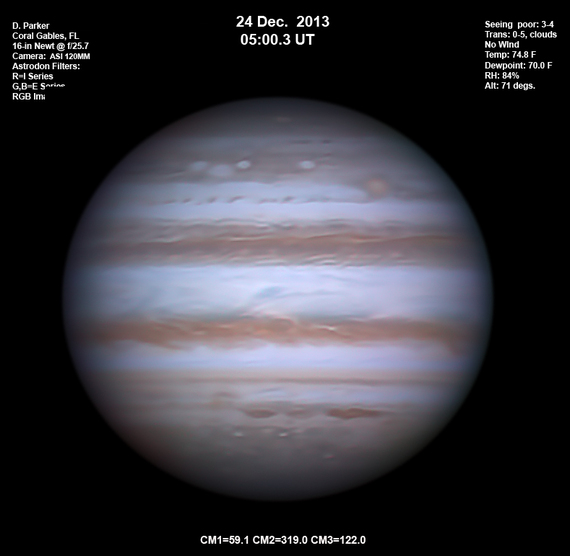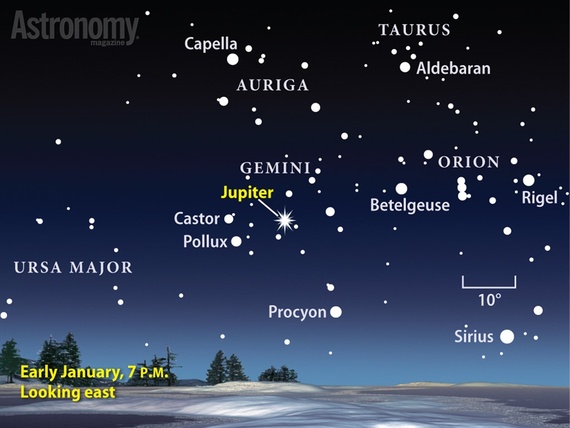The King of Planets starts off the New Year with a bang. Jupiter is at its best for the year during the first few days of January, shining brilliantly at a point in the sky astronomers call opposition -- opposite the Sun. This means it's at maximum brilliancy, reflecting the greatest amount of sunlight straight back to us, and it's also visible all night, rising at sunset and setting at sunrise.
The largest planet in our solar system is so large that it could hold 1,266 Earths within its volume. It is not, as some have said, a "failed star," being only a fraction of the mass it would take to ignite nuclear fusion, the mechanism by which stars shine.
But it is a treat in our skies, and never better than right now. Consider this spectacular image taken by amateur astronomer Don Parker from Coral Gables, Florida, on December 24, 2013:

Credit: Don Parker
The photograph shows a multitude of cloud features in the planet's upper atmosphere, some of which can be seen in telescopes used by amateur astronomers.
But you won't need a telescope to see Jupiter. On January 5, at opposition, the planet shines magnificently at magnitude (-2.7) making it brighter than any of the stars in the sky. The planet will also lay high in the sky.
In a small telescope, you'll be able to see the planet's cloud belts and bands, and the four small moons lined up around the planet that were discovered in 1610 by Galileo -- Ganymede, Europa, Callisto and Io. Observe the planet on successive evenings, and you'll be able to see these moons -- which appear like tiny "stars," -- dance in their positions around the big globe of Jupiter.
You can use this map to find Jupiter:
Credit: Astronomy: Roen Kelly
While you look at Jupiter, you might consider that this planet might have played a role in why we are here today. The solar system contains numerous small bodies -- comets and asteroids -- and Jupiter often acts as a "cosmic vacuum cleaner," sweeping up some of these rocks and chunks of ice, preventing them from moving in to perhaps impact Earth.
And also realize that Jupiter is the largest gas giant planet in our solar system (although Saturn's rings are prettier!) but that astronomers have, over the past decade and a half, discovered quite a few Jupiter-like planets orbiting stars near us in the galaxy. Many, many Jupiters are out there in the distant dark reaches of the cosmos.
You can learn more about observing Jupiter at Astronomy.com.
Support HuffPost
Our 2024 Coverage Needs You
Your Loyalty Means The World To Us
At HuffPost, we believe that everyone needs high-quality journalism, but we understand that not everyone can afford to pay for expensive news subscriptions. That is why we are committed to providing deeply reported, carefully fact-checked news that is freely accessible to everyone.
Whether you come to HuffPost for updates on the 2024 presidential race, hard-hitting investigations into critical issues facing our country today, or trending stories that make you laugh, we appreciate you. The truth is, news costs money to produce, and we are proud that we have never put our stories behind an expensive paywall.
Would you join us to help keep our stories free for all? Your contribution of as little as $2 will go a long way.
Can't afford to donate? Support HuffPost by creating a free account and log in while you read.
As Americans head to the polls in 2024, the very future of our country is at stake. At HuffPost, we believe that a free press is critical to creating well-informed voters. That's why our journalism is free for everyone, even though other newsrooms retreat behind expensive paywalls.
Our journalists will continue to cover the twists and turns during this historic presidential election. With your help, we'll bring you hard-hitting investigations, well-researched analysis and timely takes you can't find elsewhere. Reporting in this current political climate is a responsibility we do not take lightly, and we thank you for your support.
Contribute as little as $2 to keep our news free for all.
Can't afford to donate? Support HuffPost by creating a free account and log in while you read.
Dear HuffPost Reader
Thank you for your past contribution to HuffPost. We are sincerely grateful for readers like you who help us ensure that we can keep our journalism free for everyone.
The stakes are high this year, and our 2024 coverage could use continued support. Would you consider becoming a regular HuffPost contributor?
Dear HuffPost Reader
Thank you for your past contribution to HuffPost. We are sincerely grateful for readers like you who help us ensure that we can keep our journalism free for everyone.
The stakes are high this year, and our 2024 coverage could use continued support. If circumstances have changed since you last contributed, we hope you’ll consider contributing to HuffPost once more.
Already contributed? Log in to hide these messages.

